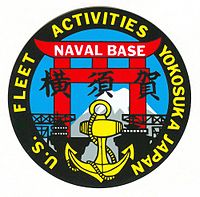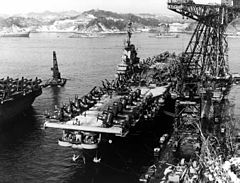- United States Fleet Activities Yokosuka
-
United States Fleet Activities Yokosuka Yokosuka, Japan 
U.S. Fleet Activities Yokosuka logoType Military Base Controlled by Japan
United StatesU.S. Fleet Activities Yokosuka, or Commander, Fleet Activities Yokosuka is a United States Navy base, in Yokosuka, Japan. Its mission is to maintain and operate base facilities for the logistic, recreational, administrative support and service of the U.S. Naval Forces Japan, U.S. 7th Fleet and other operating forces assigned in the Western Pacific. CFAY is the largest strategically important U.S. Naval installation in the western Pacific.[1] As of August 2011[update], it is commanded by Captain David Owen.
Fleet Activities Yokosuka comprises 2.3 km² (568 acres) and is located at the entrance of Tokyo Bay, 65 km (40 mi) south of Tokyo and approximately 30 km (20 mi) south of Yokohama on the Miura Peninsula in the Kantō region of the Pacific Coast in Central Honshū, Japan.
The 55 tenant commands which make up this installation support WESTPAC operating forces, including principal afloat elements of the United States Seventh Fleet and Destroyer Squadron 15, including the only permanently forward-deployed aircraft carrier, USS George Washington (CVN-73).
Contents
History
When Commodore Matthew Perry arrived in Japan in 1853, using naval pressure to open up Japan to foreign trade, Yokosuka was a quaint, native fishing village. In 1860, Lord Oguri Kozuke-no-Suke, Minister of Finance to the Tokugawa Shogunate Government, decided that "If Japan is to assume an active role in world trade, she must have proper facilities to build and maintain large seagoing vessels." He called upon the French Consul General, Léon Roches, and asked for the assistance of the French government to build a shipyard capable of handling large ships. The French engineer Léonce Verny was sent to Japan to accomplish the task. After the inspection of several sites it was discovered that Yokosuka topographically, if on a smaller scale, resembled the port of Toulon, France. It was decided to establish the shipyard here. It would be called the "Yokosuka Iron Works". In 1871, the name was changed to the "Yokosuka Navy Yard". It was the French engineer Louis-Émile Bertin 1840-1924 who reorganized "Yokosuka Navy Yard" completely from 1886.
Yokosuka was to become one of the main arsenals of the Imperial Japanese Navy into the 20th century, in which were built battleships such as Yamashiro, and aircraft carriers such as Hiryu and Shokaku. Major Naval aircraft were also designed at the Yokosuka Naval Air Technical Arsenal.
During World War II, activities at the Yokosuka Navy Yard reached their peak. By 1944, the Yard covered 280 acres (1.1 km2) and employed over 40,000 workers. In addition to the shipbuilding plant, the yard also had a gun factory, ordnance and supply depots, a fuel storage facility, a seaplane base and a naval air station.
 USS Oriskany (CVA-34) at Yokosuka, circa 1952
USS Oriskany (CVA-34) at Yokosuka, circa 1952
 The U.S. Navy base at Yokosuka, with USS George Washington (CVN 73)
The U.S. Navy base at Yokosuka, with USS George Washington (CVN 73)
 Yokosuka, Japan (Jun. 23, 2003) -- Vice Adm. Takashi Saito, Commandant, Yokosuka District Japanese Maritime Self Defense Forces (JMSDF), and Capt. Michael Seifert, Commanding Officer Fleet Activities Yokosuka, sign a Memorandum of Understanding (MOU) at the JMSDF Commandant Yokosuka District Headquarters. The MOU provides a framework under which the two maritime forces will conduct force protection exercises in Yokosuka.
Yokosuka, Japan (Jun. 23, 2003) -- Vice Adm. Takashi Saito, Commandant, Yokosuka District Japanese Maritime Self Defense Forces (JMSDF), and Capt. Michael Seifert, Commanding Officer Fleet Activities Yokosuka, sign a Memorandum of Understanding (MOU) at the JMSDF Commandant Yokosuka District Headquarters. The MOU provides a framework under which the two maritime forces will conduct force protection exercises in Yokosuka.
On 30 August 1945, Vice Admiral Michitaro Totsuka, Commander of the Yokosuka Naval Base, surrendered his command to Rear Admiral Robert Carney, and the Base was peacefully occupied by U.S. Marines of the 6th Marine Division, British Royal Marines and U.S. Naval personnel. Commander Fleet Activities (COMFLEACT) Yokosuka was created shortly after the occupation in 1945. As the Base became organized, the shipyard was deactivated and much of the equipment was sent to other countries as part of reparations. The repair ship Piedmont took charge of ship repair and maintenance, the hospital became a Naval Dispensary, and the Supply Department was organized with the mission to provide full support to the U.S. Fleet and shore-based activities. The Public Works Department was also established.
The best known Commander of Fleet Activities was the one who served here the longest, Captain Benton W. "Benny" Decker, who was in command from April, 1946 until June, 1950. When he assumed command, the base was fairly well-organized, and Captain Decker and his staff were able to devote their time to helping the townspeople economically, politically and socially. Buildings which had once housed war equipment were converted into schools, churches and hospitals for the people of Japan.
In May, 1946, the Marines at Yokosuka were redesignated Marine Barracks, U.S. Fleet Activities, Yokosuka. In April, 1947, the Ship Repair Department was organized, and the shops and dry docks were reactivated to maintain the ships of the U.S. Fleet in the Pacific. With the onset of the Korean War on 25 June 1950, Yokosuka Navy Base suddenly became very important and extremely busy.
The U.S., although still an occupying power in Japan, turned its full efforts to the support of South Korea. The Navy Dispensary was enlarged and expanded and was commissioned a U.S. Naval Hospital in 1950. The Naval Communications Facility, Yokosuka, was commissioned in January, 1951. In April 1951, the Ship Repair Department became a component command. It was redesignated the Ship Repair Facility. As the major naval ship repair facility in the Far East, the Yokosuka Facility assumed a vital role in maintenance and repair of the U.S. Seventh Fleet during the Korean War and Vietnam War.
In March, 1952, the geographical boundaries of the command of Commander Naval Forces Far East changed to exclude the Philippines, Marianas, Bonin and Volcano Islands. In December, 1952, the Headquarters were shifted from Tokyo to Yokosuka. The expanded Supply Department of Fleet Activities became the Naval Supply Depot, Yokosuka in August, 1952 and in 1960, the Naval Communications Facility was redesignated U.S. Naval Communications Station, Japan.
On 5 October 1973 USS Midway, with CVW-5 and her accompanying task group put into Yokosuka, marking the first forward deployment of a complete carrier task group in a Japanese port. This was the result of an accord arrived at on 31 August 1972 between the U.S. and Japan. In addition to the morale factor of dependents housed along with the crew in a foreign port, the move had strategic significance because it facilitated continuous positioning of three carriers in the Far East at a time when the economic situation demanded the reduction of carriers in the fleet. In August 1991, Midway departed Yokosuka and turned over to Independence, which was replacing Midway as the forward-deployed carrier in Yokosuka. In August 1998 Kitty Hawk relieved Independence as the 7th Fleet forward-based carrier.
On 1 December 2005, the U.S. Navy announced that in 2008 the USS Kitty Hawk will be replaced at its forward base in Yokosuka by the nuclear powered Nimitz-class aircraft carrier George Washington. A U.S. Navy spokesman said the decision was a mutual agreement between the United States and Japan. Hiroyuki Hosoda, spokesman for Japan's government, said, "We believe that the change (of the carriers) will lead to maintaining the solid presence of the U.S. Navy and contribute to keeping Japan's security and international peace into the future." This would be the first time a nuclear powered ship would be permanently based in Japan.
On 25 September 2008, the USS George Washington arrived in Yokosuka making it the only forward-deployed nuclear-powered aircraft carrier in the U.S. Navy.[2]
In recent years, a number of high profile international incidents involving American sailors occurred around the base. The most notable were two murders which occurred in 2006 and 2008. The first murder was committed by Airman William Oliver Reese, who beat to death 56-year-old Yokosuka woman Yoshie Sato and proceeded to take the equivalent of $130 from her purse.[3] The second murder was committed by Seaman Olantunbosun Ugbogu, a Nigerian citizen who had joined the U.S. Navy, but had not yet received citizenship. Ugbogu stabbed a taxi driver to death in order to avoid paying a $200 fare, which he had incurred returning from Tokyo.[4] He was stationed aboard the guided missile cruiser USS Cowpens (CG-63), but was absent without leave at the time of the murder and considered a deserter. Both murders resulted in the U.S. Navy severely restricting the liberty of all sailors in the fleet.[5]
Personnel and ships from the base assisted with Operation Tomodachi following and during the March 2011 Tōhoku earthquake and tsunami and Fukushima I nuclear accidents. During the crisis, around 3,000 American family members voluntarily departed the base for locations outside Japan.[6]
Forward-deployed ships
Command Ship
Aircraft Carrier
Cruisers
Destroyers
- USS Curtis Wilbur (DDG-54)
- USS John S. McCain (DDG-56)
- USS Fitzgerald (DDG-62)
- USS Stethem (DDG-63)
- USS Lassen (DDG-82)
- USS McCampbell (DDG-85)
- USS Mustin (DDG-89)
Landmarks
During the late 1960s and 1970s, the Yokosuka Microwave Communications Site was part of the telephone communications network in the Tokyo area of Japan.[7]
The location of the building and 106.7 metre tall microwave tower was on the highest hill on the U.S. Navy base.
References
- ^ Command History CFAY Yokosuka
- ^ USS George Washington makes historic arrival in Japan. Stars and Stripes
- ^ Stripes.com
- ^ Stripes.com
- ^ Stripes.com
- ^ Reed, Charlie, "Military wraps up first round of departures from Japan", Stars and Stripes, 25 March 2011, retrieved 28 March 2011.
- ^ Yokosuka-microwave-site-1969-1970.stevemcarthur.com
External links
- Yokosuka Fleet Activities Base #1 Community Website
- U.S. Fleet Activities Yokosuka official website
- U.S. Naval Hospital Yokosuka official website
Coordinates: 35°17′36″N 139°40′17″E / 35.2932°N 139.671293°E
Categories:- United States Navy bases
- Kanagawa Prefecture
- Yokosuka
- Military bases of the United States in Japan
Wikimedia Foundation. 2010.


